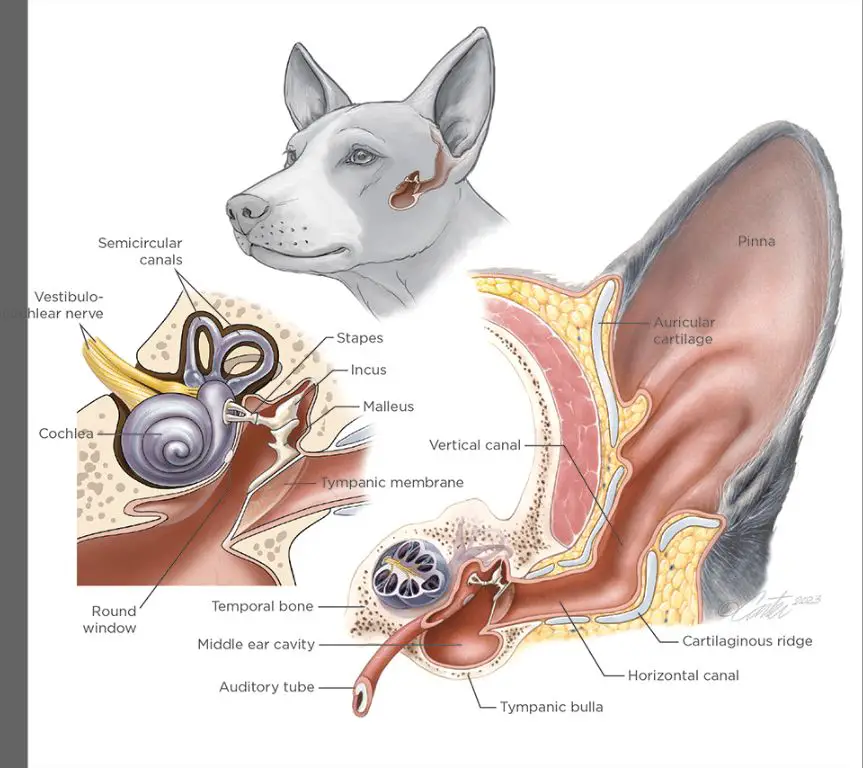Introduction
This article explores how dogs hear, with a focus on dog breeds that have the best hearing. We will cover the frequency range and sensitivity of canine hearing and compare it to human hearing. The sections in this article include:
An overview of how dogs hear and the anatomy behind their excellent auditory abilities
Details on sound frequency range and sensitivity of hearing in dogs
Explanation of directional hearing and how dogs can localize sound
A list of dog breeds with the top hearing capabilities
Examples of how dogs use their acute hearing in different situations
Tips for caring for dogs’ hearing health
Signs of potential hearing loss in dogs and what to watch out for
By the end of the article, you’ll have a comprehensive understanding of dogs’ impressive sense of hearing, which dog breeds are the most gifted listeners, and how to keep your dog’s ears in optimal condition.
How Dogs Hear

A dog’s incredible sense of hearing is thanks to their unique ear anatomy. Dogs have large movable outer ears called pinnae that capture sound waves and funnel them into the ear canal. Inside the ear canal, sound waves cause the eardrum to vibrate. These vibrations pass through the middle ear bones called the malleus, incus and stapes which amplify the vibrations before sending them to the inner ear. The inner ear contains fluid filled canals for balance and the organ of Corti which contains tiny hair cells that convert vibrations into neural signals that the brain interprets as sound. Dogs have more ear muscles than humans which allows them to rotate their ears independently. They also have larger ear canals and a much wider range of hearing frequencies and sensitivities. According to Through a Dog’s Ear (through-a-dogu0027s-ear-speaker.innovexbyte.cfd), dogs can hear sounds between 67-45,000 Hz, while humans only hear between 64-23,000 Hz.
The key anatomical differences that give dogs such great hearing are:
- Large movable pinnae to capture more sound waves
- Larger ear canals amplify the sound
- More ear muscles for directional hearing
- Increased inner ear hair cells detect wider frequency range
Sound Frequency Range

Dogs can hear sounds at much higher frequencies than humans can. While the average human can hear sounds between 64-23,000 Hz, dogs can hear frequencies from 67-45,000 Hz 1. This means dogs can detect sounds up to 4 times higher than the top end of the human hearing range.
For example, dogs can hear high-frequency dog whistles that emit sounds of 23,000 Hz or higher. The high-pitched sounds of squeaky toys, which contain frequencies up to 50,000 Hz, are also audible to dogs but inaudible to humans 2. This wider frequency range allows dogs to hear sounds that humans simply cannot detect.
Hearing Sensitivity
Dogs have an incredibly acute sense of hearing and can detect sounds as quiet as 15-20 decibels compared to humans who can only hear down to about 60 decibels. This means dogs can hear sounds 4 times quieter than humans can. For example, while the average human conversation is about 60 decibels, dogs can hear whispers down to about 30 decibels.
Dogs are able to hear higher frequency sounds that humans can’t detect. The average human can hear sounds up to about 20 kHz, while dogs can hear pitches up to 45 kHz. This allows dogs to hear things like high-pitched whistles and dog whistles that emit sounds from 23 to 54 kHz.
According to one source, dogs have such sensitive hearing that they can hear things at the level of minus 6 decibels. This means they can pick up incredibly subtle sounds that humans would never notice. Their hearing is so keen that they can hear sounds that are 10 million times quieter than sounds humans can detect.
This increased sensitivity allows dogs to pick up on noises and cues that we miss. It’s why they may start barking when they detect something we can’t hear yet. Their hearing gives them an awareness of their environment that surpasses our own.
Directional Hearing
Dogs have the ability to move their ears independently, which gives them an advantage in discerning the direction of sounds. While human ears are immobile, a dog can turn their ears like satellites to precisely pinpoint where a sound is coming from (VCA Animal Hospitals). When dogs tilt their heads, it allows them to further enhance their directional hearing by aligning the ear at an angle to the source of the sound.
A dog’s movable outer ears help them locate the origin of sounds. Their brain analyzes the minute differences in timing and loudness between their two ears to figure out which direction the sound is coming from. This directional hearing gives dogs an environmental awareness that helps them detect prey or possible threats. However, their directional hearing is more limited compared to humans. The shape of the human ear is highly engineered to pick up sounds efficiently without having to turn toward the source (Wagging Tails Pet Resort).
Best Hearing Dog Breeds
Certain dog breeds stand out for their exceptional hearing abilities. Breeds such as hounds and shepherds have developed keen hearing to aid in hunting and herding tasks. Here are some top dog breeds with the best sense of hearing:
German Shepherd – German Shepherds have large, erect ears that can rotate to pick up sounds from all directions. They are intelligent working dogs with a strong protective instinct that contributes to their excellent hearing (Living with a Hearing Dog).
Beagle – Beagles have long, droopy ears that help funnel sound. They were originally bred as hunting hounds, relying on their sense of smell and hearing to track prey. Beagles can hear faint sounds from far away (hearing dog – Service Animals for the Deaf and Impaired).
Labrador Retriever – Friendly and energetic Labs make great hearing dogs. Their wide, short ears allow them to accurately locate the source of sounds. Labs are eager to please and highly trainable (Hearing Dogs – What Do You Need to Know About Them?).
Cocker Spaniel – Cocker Spaniels have long, wide ears that catch sound waves. They were originally bred to flush out woodcock birds by following vocal cues. Cockers can differentiate subtle tone changes.
Australian Cattle Dog – Australian Cattle Dogs have strong upright ears and acute listening abilities, allowing them to control herds in open pasture. Their sensitivity to sound makes them excellent hearing dogs.
Uses of Dog Hearing
Many working dogs rely heavily on their excellent sense of hearing to perform critical tasks. For example, hunting dogs like Labradors and Beagles use their hearing to track and locate game birds in the field. Their ability to detect subtle sounds and pinpoint the direction allows them to guide hunters towards the prey. According to one source, “Protecting hunting dogs hearing while allowing the dog to hear important sounds is vital.” (Crittear)

Herding dogs like Border Collies also depend on acute hearing to control livestock. They are able to hear and respond to whistles and commands from their owners from long distances away amidst noisy environments. Their directional hearing helps them locate stray members of a herd and guide them where needed. Protecting a herding dog’s hearing is crucial so they can continue doing their job safely and effectively.
Working military and police dogs such as German Shepherds use their sensitive hearing for tasks like detecting suspicious sounds or finding people amid rubble or debris. Protecting their hearing allows them to keep performing heroically for years. Purpose-built hearing protection like mutt muffs helps prevent noise-induced hearing loss in working dogs exposed to loud sounds like gunfire while still allowing them to hear commands and cues at safe levels.
Caring for Dog Hearing
There are several ways you can help protect your dog’s sensitive hearing:
– Avoid exposing your dog to excessively loud noises like fireworks, gunshots, or loud concerts. Exposure to noises over 100 decibels can damage hearing over time [1].
– Clean your dog’s ears regularly to remove debris and wax buildup. Gently wipe inside the ears using a cotton ball soaked in a veterinary ear cleaning solution. Never use Q-tips or insert objects into the ear canal [2].
– Have your vet check your dog’s ears during annual exams to screen for infections or other issues. Signs of hearing loss like not responding to noises warrant a veterinary visit.
– Limit medications like certain antibiotics that can damage hearing if alternatives are available.
– Speak to your vet about supplements that support ear and hearing health.
Protecting your dog’s hearing will help preserve their ability to interpret useful sounds in their environment and interact with you.
Signs of Hearing Loss
There are several signs that may indicate a dog is experiencing hearing loss. Some of the most common signs include:

- Not responding to sounds or cues that used to get the dog’s attention, like doorbells, knocks, their name being called, or the sounds of food preparation (Citation: Hearing Loss in Senior Dogs — Symptoms and Management)
- Increased startle response or confusion when approached or touched from the side or behind where the dog can’t see the person (Citation: Signs of Hearing Loss in Dogs)
- Excessive, loud, or chronic barking which may indicate the dog cannot hear itself (Citation: Signs of Hearing Loss in Dogs)
- Sleeping more soundly and not waking up to noises that would normally alert them (Citation: Hearing Loss in Senior Dogs — Symptoms and Management)
- Less focused during training or reduced response to obedience cues (Citation: Deaf Dogs: Living with Hearing Loss)
If a dog is displaying any of these signs, it’s a good idea to have their hearing tested by a veterinarian. Catching hearing loss early allows adaptations to be made to help the dog live happily with diminished hearing.
Conclusion
In summary, dogs have an incredibly impressive sense of hearing compared to humans. Their wider range of audible frequencies, superior sensitivity, and ability to pinpoint sound direction allow them to perceive our world very differently. While all dogs have great hearing, certain breeds like Bloodhounds, German Shepherds, and Cocker Spaniels are exceptionally gifted in this area. Understanding dogs’ exceptional hearing capabilities allows us to care for them properly by being mindful of loud noises that can damage their hearing and negatively impact their behavior. Dogs’ keen hearing is a reminder of their remarkable sensory abilities. When properly nurtured, their hearing allows dogs to thrive and live up to their full potential as our loyal companions.
